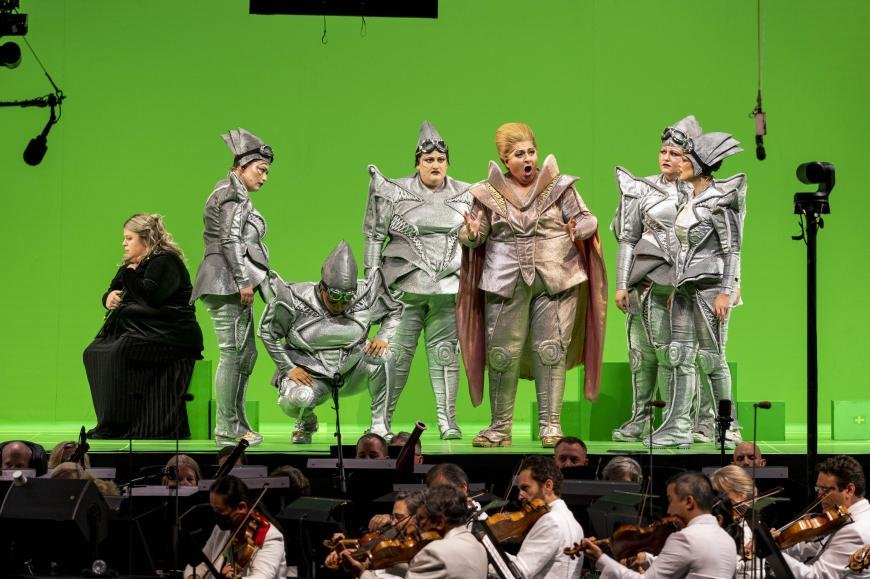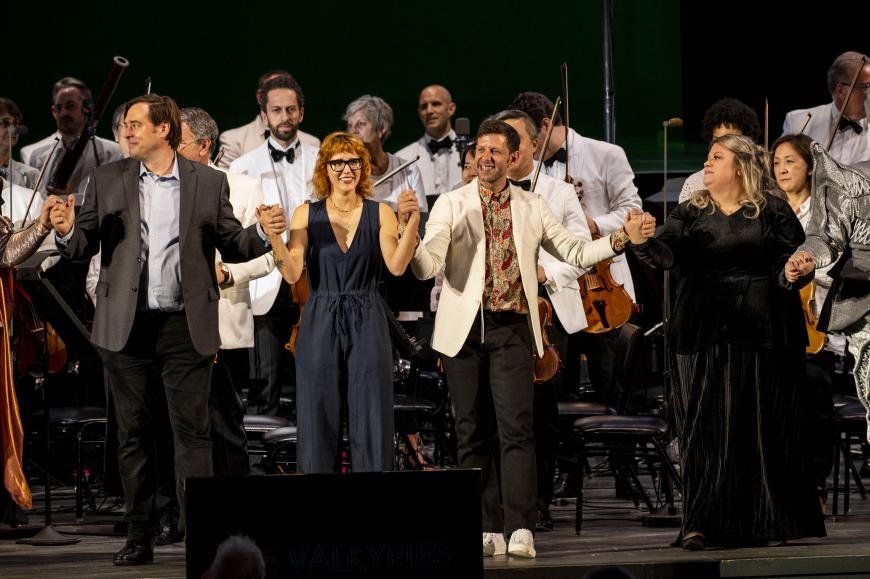Flight of Valkyries at the Bowl, in Spacesuits
/By Truman C. Wang
7/17/2022
Photo credit: Timothy Norris / L.A. Phil
Last Sunday’s sci-fi staging of Act III of the Walküre at the Bowl was enjoyed by all – the Star Wars/videogame fans as well as diehard Wagnerites. It’s a co-production with Detroit Opera, where Yuval Sharon is the Artistic Director. The ‘director’s concept’ is a simple but ingenious one: singers move around in front of a giant green screen, upon which a team of video animation artists and stagehands (clad in green bodysuits) work their magic behind the scene to put the singers inside a fairly faithful replica of Wagner’s fantasy world, albeit in the retro 1980’s videogame graphics. The finished product was projected onto the Bowl’s video screens and eight TV monitors for the pool section. A minor annoyance was the constant turning of heads to and from the stage; would be nicer to have a giant center screen hanging above the stage.
Yuval Sharon’s electronic virtual “décor” is probably closer to Wagner’s scenic directions than that of many a contemporary (or traditional) production. The 1985 San Francisco Ring, called “the best-looking” by Andrew Porter, was sadly weighed down by director Lehnhoff’s silly stage business. Then there was the L.A. Opera’s 2010 Achim Freyer Ring, an expensive $32 million fiasco, about which the less said, the better. The Valkyrie space fantasy film begins with actress Sigourney Weaver giving a short plot summary, followed by a vivid animation of the Valkyries in spacesuits hurtling through space on their pod racers. The encounter of an angry giant Wotan and cowering Lilliputian Valkyries is an ingenious touch, as well as the visual depictions of the many musical motifs (the Valhala zoom-in, Notung sword pieces becoming whole again, raging storms, etc.) – making Wagner’s long monologs and duets less tedious than usual. The final twenty minutes of the “Magic Fire Music”, in which Brünnhilde becomes encased inside a giant ice globe, encircled by Loge’s fire, was visually stunning and emotionally draining.
One benefit of the video production is the singers do not need to strain physically to move around large sets, and can focus all their energy on singing. The cast, led by Christine Goerke’s Brünnhilde and Matthias Goerne’s Wotan, were splendid. Goerke’s sizeable voice was as I had remembered from Houston’s Götterdämmerung – warm, rich, powerful from the lowest notes to the top register, and full of expressiveness. Goerne’s bass-baritone was noble, firm, commanding and vocally resplendent especially in the moving “Wotan’s Farewell”. The text was trenchantly pronounced, every word clear, every line expressive in the true belcanto style.
Gustavo Dudamel arranged the L.A. Phil strings in the traditional fashion: second violins on his right, and therefore properly prominent in the opening “Flight of the Valkyries”, cellos facing out and wonderfully eloquent throughout the evening. Brass passages were brilliant and the kettledrum firmly incisive. The overall orchestral sound – rich and stirring, detailed in solos and glowing in tutti – made one eager for the complete Ring at the Walt Disney Concert Hall.
Truman C. Wang is Editor-in-Chief of Classical Voice, whose articles have appeared in the Pasadena Star-News, San Gabriel Valley Tribune, other Southern California publications, as well as the Hawaiian Chinese Daily. He studied Integrative Biology and Music at U.C. Berkeley.



